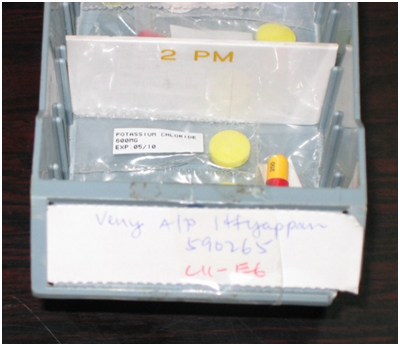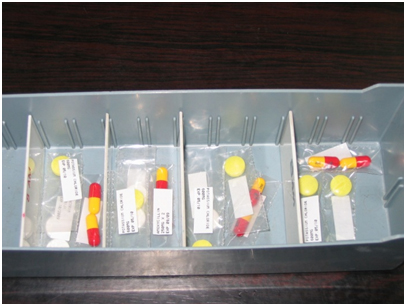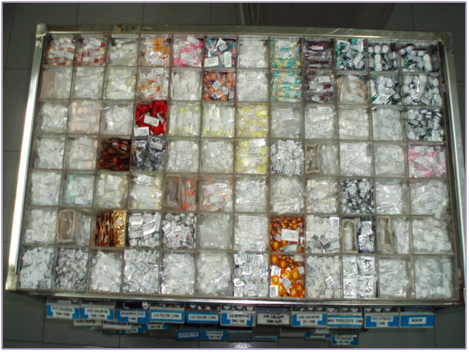 Drug Distribution System
Drug Distribution System
The unit dose system is defined as a pharmacy coordinated method of dispensing and controlling medications in health care institutions. This system is characterized by medications contained in unit dose packages, dispensed in ready-to-administer form, and not more than 24-hour supply. All medication dispensed to patients in the wards should be kept in individually labelled drawers or trays in the medications trolleys for patients. The quantity of medication dispensed should be according to the dosage regimen and placed in compartments within the patient drawers. Unlike unit of use and floor stock, unit dose requires pharmacist to dispense patient-specific medications ready to be administered, and not prepared by nurses. A registered nurse in the particular ward and an authorized pharmacy staff should always lock the medication trolley and keep the key safely. The unit dose system was considered the most cost effective system when the entire medication use cycle is considered.
Few criteria of UDS:
- Medications in unit dose are individually packaged and labelled with name, dose, batch no. and expiry date.


- Medications are dispensed in readily administered form.
- Medications are supplied on a daily basic, not more than 24 hours supply.
- The medications are individually labelled and placed in separate compartment within patient drawer within the medication trolley ready for dispense.


ADVANTAGES:
The unit dose method provides the advantages as the following.
- Reduction in medication errors.
- Improved drug control and drug use monitoring.
- Minimization of credits for drugs.
- Greater control by pharmacist over work patterns and scheduling.
- Patient medication profile, the CMR is concurrently maintained in the pharmacy for each patient, so pharmacists can involve in monitoring patient care.
- More efficient use of pharmacy and nursing personnel.
- All doses of medication required are prepared by the pharmacy thus allowing the nurses to have more time for direct patient care.
- Intravenous preparation and drug reconstitution procedures are transferred to the pharmacy.
- Since the amount of medications is restricted to the patient needs for 24 hour only, reduced pilferage and drug wastage.
- Reduces revenue losses.
- The size of floor stock is reduced; floor stock is limited to drugs for emergency use and routinely used safe items. Conserve space in nursing unit, and this help to reduce cost as inventory control would be maximized.
- More accurate patient billing for medications. Patients are charged for only those doses which are administered to them.
DISADVANTAGES:
- Manual packing of unit dose is time consuming and labour intensive.
- Increase volume of work in pharmacy, more pharmacists is needed around for the whole dispensing process.
- Frequent ordering as orders are done on daily basic.

Drugs can be supplied via UDS:
- Oral Solids: Tablets form, Capsules form, Blister package form, Pouch package form.
- Oral Liquids: Solutions, Suspensions, Syrups, Elixirs, Emulsions.
A container designed to permit the unit dose administration of liquid. Reconstitution by nursing is not required as it has been done by the pharmacist. The label should state the contents as follows: Delivers ____mg (or g or mcg) in ____ml.
- Transdermal patch
- Suppository, pessary
- Ampoules
Drugs not supplied via UDS:
- Inhalational: Aerosol, Inhaler, and Nebulizer
- Cream, gel, ointment, lotion and paste
- Eye drops, nasal drops and sprays
- Radioactive pharmaceuticals
- Cytotoxic drugs
- Parenteral preparations: injections, intravenous infusions, powders for injections, implants
The procedure of dispensing:
- Screening and charting in CMR by one pharmacist A.
- Filling medications into patients’ drawers in medication trolley by pharmacist B
- UD supply checked by Pharmacist C.
- Received by ward nurse.
- Pharmacist checks patients’ drawers upon return of the trolley.
All the staffs involved in the dispensing must sign in Unit Dose Dispensing Checklist after completing their works.












